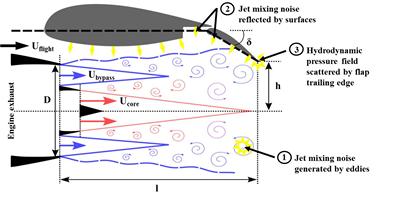Research project: Why Do Wings Make Engines Noisier?
When an aircraft engine mounted under a wing it makes more noise than one on a testbed
When an aircraft engine mounted under a wing it makes more noise than one on a testbed
Turbo-fan engines can produce noise in a variety of ways but principally from the fan, turbine and jet. Unlike the other two, jet noise is not produced inside the engine but results from the energetic turbulent mixing of the high speed flow coming from the engine with the atmosphere. However, it is also found that this “mixing noise” is enhanced by what is known as “jet-wing interaction” – that is, an engine mounted under a wing produces more noise than an identical engine that is tested without a wing present, an “isolated jet”.

Since they were first introduced, turbo-fan engines have become larger for the same thrust (higher bypass ratio). This has brought both improved aerodynamic performance and decreased levels of jet mixing noise. Unfortunately, it has also meant that the engine has to be coupled more closely to the wing and this has brought the disadvantage of increased jet wing installation effects. The point is now being reached where the disadvantages outweigh the advantages and there is a need to find ways of reducing the jet-wing effects. Before this happens we need to understand the details of processes that bring about the enhanced noise of an installed jet. So just why do wings make jets noisier?
In principle we know the answer to this question. There are three mechanisms that contribute: reflection, change in mixing noise, and scattering of the jets hydrodynamic pressure field.

The first way wings make jets noisier is by reflecting some of the noise that would otherwise propagate upward away from anyone on the ground. While conceptually easy to understand, predicting exactly what happens is difficult because the reflected noise is refracted by the jet flow. We have developed a number of orograms for predicting these effects that are currently in use by Rolls-Royce.
Wings also affect the flow structure of the jet and this can alter the mixing noise. We account for these affects using out jet mixing noise programs.
Finally, and of current concern, is noise produced by scattering by the wing and flap of the jet’s hydrodynamic field. In other contexts hydrodynamic fields are often referred to as “pseudo sound”. They are pressure fields that vary in time but do not propagate very far from the source. However, when such fields encounter the edge of a surface their energy can be converted into true sound fields that will propagate and be heard by a distant observer.

We are undertaking an extensive experimental campaign at the Institute of Sound and Vibration Research Doak Laboratory and at our partner’s QinetiQ Noise Test Facility to help understand the exact details of how wings effect turbulence and hydrodynamic fields. In this way we will be able to develop better theories and hence predictions of jet wing interaction.